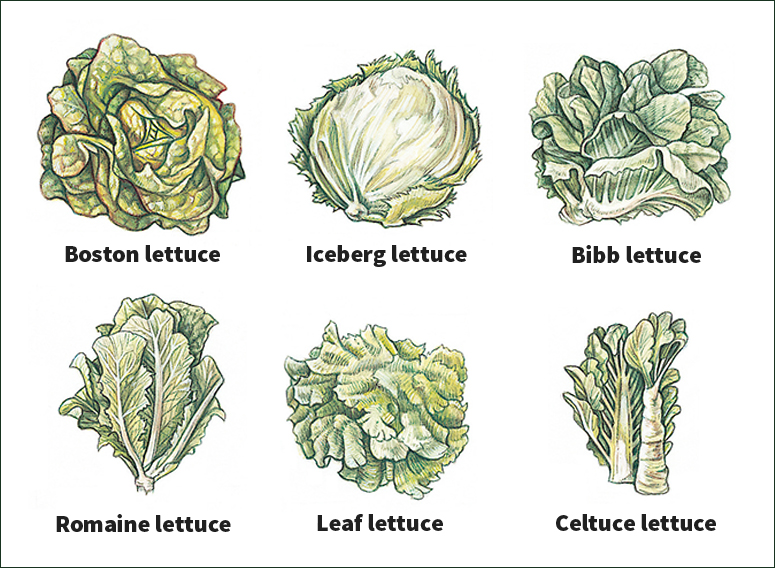Lettuce is a popular vegetable used chiefly in salads. People usually eat it fresh and uncooked. Lettuce forms a part of many weight-control diets because it contains few calories and provides calcium, iron, and vitamin A. Most kinds of lettuce have large, green leaves and grow close to the ground on extremely short stems. Lettuce ranks as an important farm crop in the United States, and home gardeners raise several varieties. Lettuce farming probably began in Persia as early as 550 B.C.

Kinds of lettuce.
There are three main kinds of lettuce: (1) head; (2) leaf; and (3) cos, or romaine.
Head lettuce
has leaves that curl around the center of the plant, forming a ball-shaped head. Crisp head lettuce, or iceberg lettuce, has a tight head and brittle, juicy leaves. Head lettuce is the major type of lettuce grown commercially in the United States. Widely grown varieties of this type include Great Lakes, Imperial, and Vanguard.
Butterhead lettuce
has a looser, more open head and soft, oily leaves. It spoils easily and so is not as popular as crisp head. Varieties of it include Bibb and Boston.
Leaf lettuce
forms dense, leafy clumps instead of heads. Gardeners grow more of it than of any other kind. Most leaf lettuce has light green leaves, but a few red varieties have been developed. The waxy, crinkled leaves vary in shape among various types of leaf lettuce. Popular varieties include Black-Seeded Simpson and Grand Rapids.
Cos, or romaine, lettuce
grows long and upright and its leaves curl inward. The leaves are tender and can be easily damaged in shipment. For this reason, cos is the least widely grown kind of lettuce even though it is the most nutritious.
Other kinds of lettuce
include celtuce and wild lettuce. Celtuce looks and tastes like a combination of celery and lettuce. Wild lettuce, from which all present-day varieties of the lettuce plant were developed, grows in mild climates throughout the world.
Growing lettuce.
Most kinds of commercial lettuce grow well in temperatures between 70 °F (21 °C) and 75 °F (24 °C). Some varieties that were developed for gardeners thrive at just below 80 °F (27 °C). In the Northeastern United States, commercial growers plant lettuce in spring for harvest during the summer. Growers in the Southern and Southwestern states plant in fall or winter for harvest during the spring.
California leads the United States in lettuce production, with about 70 percent of the country’s commercial crop. Crisp head lettuce grows nearly the year around in the cool Salinas Valley of California. The other top lettuce-growing states are, in order of importance, Arizona, Florida, Colorado, and New York.
Planting and cultivating.
Most commercial lettuce growers plant their crop directly in the field. Some growers in the Northeastern United States plant seedlings that have been raised in greenhouses. Many gardeners also plant seedlings. In some areas, winter lettuce crops may be grown entirely in greenhouses.
Weeding and fertilizing should take place at or just below the surface of the ground, or the plant’s shallow root system may be injured. Lettuce requires a steady supply of water and fertilizer.
Harvesting.
Workers harvest lettuce by cutting off the heads just above the soil. Then they remove any dead or damaged leaves. Head and cos lettuce are harvested when the leaves are firmest, about 70 to 90 days after seeding, depending on the variety. Leaf lettuce can be harvested whenever the leaves reach the desired size.
Packing and shipping.
Lettuce spoils quickly and must be packed, cooled, and shipped immediately after being cut. On most lettuce farms, workers pack and vacuum cool the lettuce in the field. The workers pack the lettuce in cardboard cartons and put the cartons into a special refrigerated truck. In this truck, the temperature of the lettuce drops to just above freezing. On some farms, the lettuce is packed between layers of crushed ice in wooden crates. The crates are then put into refrigerated trucks or railroad cars for shipment to market.
Diseases and insect pests.
The chief diseases of lettuce include bottom rot, downy mildew, and lettuce drop. Crop rotation and chemical treatment of the soil help prevent these diseases. Another disease, tipburn, may be caused by too much heat or humidity. Scientists have developed types of lettuce that resist tipburn. These types include Minetto and Fulton.
Such insect pests as aphids, cabbage loopers, and cutworms destroy lettuce leaves and stems. However, the majority of these pests can be controlled through the use of insecticides.
